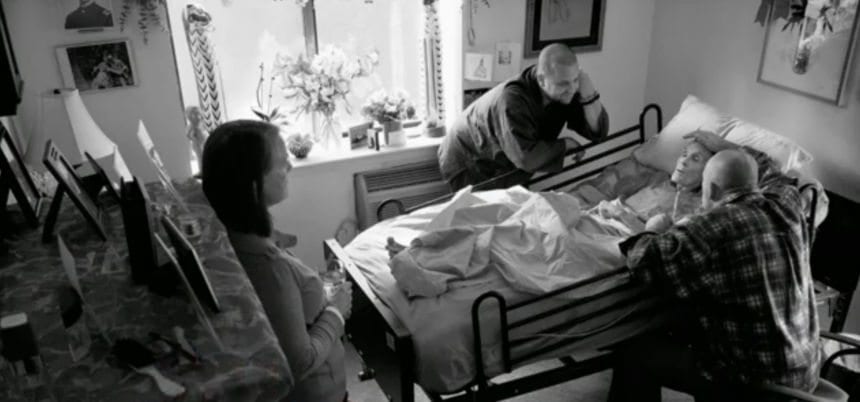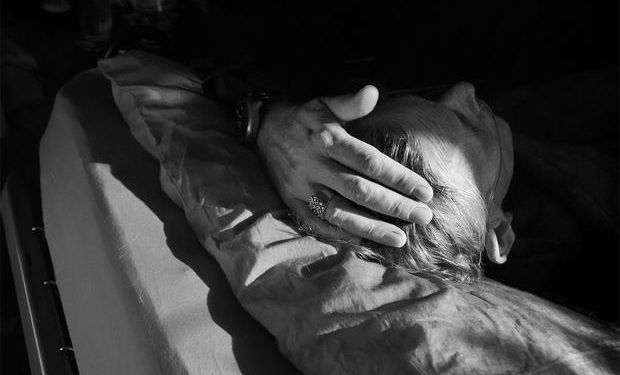Bringing Contemplative Care into the Healthcare System
A Conversation with Katy Butler, Koshin Paley Ellison, and Robert Chodo Campbell
By Garrison InstituteJoin us for the Fourth Biennial Contemplative Care Symposium, Building a Community of Care, on November 8-11. This is a collaborative event that champions theories of contemplative healthcare, put on by New York Zen Center for Contemplative Care and The Garrison Institute. Click here for info and to register.
Leading up to the symposium, NYZCCC cofounders Koshin Paley Ellison and Robert Chodo Campbell spoke with journalist Katy Butler, author of the award-winning book Knocking on Heaven’s Door: The Path to a Better Way of Death, about ways to bring the wisdom gained through face-to-face caregiving into the complexities of the healthcare system.
Katy Butler: When you walk into the ICU and spaces where people are often towards the end of their lives, how do you cope with the emotions that come up for you?
Koshin Paley Ellison: I’m anchored by the sense of community that I feel. One of the reasons we started the New York Zen Center for Contemplative Care is that we felt like there was so much isolation among people caring for people towards the end of their lives and we wanted to offer them a sense of community.
At the moment, I’m thinking specifically about one person who came into the center recently. His wife is very sick and everyone keeps coming up to him and saying, “Oh, don’t worry, she’ll be fine. She’s going to pull through this.” He feels more and more isolated by these kinds of comments. Often we just need to be able to hold each other in the unknowing groundlessness of these kinds of situations.
Robert Chodo Campbell: There is the unknowing aspect, but then there’s also the certainty of death for all of us. Why do we not talk about this stuff more? Something I often think about when I walk into an ICU is the centrality of beds in our lives. Most of us are born in a bed and, here we are, dying in a bed. There’s something beautiful about that continuum. Perhaps we can get people to look at their beds and say, “This is the great container of everything that happened in between birth and death.”
Katy Butler: Do you find that people often have an inner knowing that they are dying? I remember talking on the phone with my mother one evening and she said, “There isn’t much time.” Then she died the next day.
Koshin Paley Ellison: Yes, I think they do. I was a primary caregiver for my grandmother. Towards the end, she and I moved into the hospice together. We had such an intimate relationship. Then, about four weeks into her hospice stay, she said, “When I’m ready, I’m going to ask you to leave the room because it will be impossible for me to leave with you here. It will be too painful.” Two weeks later, which was actually on Chodo’s birthday, we woke up and she turned to me and said, “You need to get The New York Times and go to the park.” I asked, “Do you think that’s a good idea?” She said, “Absolutely.” We said goodbye.
It was one of the most challenging moments of my life because I knew that this was it. I can still remember the feeling of my lips on her forehead and cheeks before going out into the park. I remember getting The Times and a coffee and sitting in the sunlight. It was a June day. I remember watching people behave as if nothing was happening and then getting the call from the hospice nurse about five minutes later. She said, “She’s gone. Take your time and come back.” How amazing is it that she knew exactly when to send me out? It was sorrowful and beautiful.
Katy Butler: Yes, that is beautiful. Without knowing the particulars of your grandmother’s situation, I am always interested how stories like this can be honored by the nuts and bolts of our medical system. In the book that I’m working on, I have a story of a woman who kind of lucked out with the system. She lived in Syracuse, New York, and was on Medicaid. She was not rich at all. She had a family that loved her. She had a terrible brain hemorrhage in her 50s and was partly disabled from then on. In her 70s, she got into a program called PACE, which is a program for people on Medicaid and Medicare designed to keep people at home so that they don’t have to go into nursing homes. Because she was on this gentle pathway that didn’t make a distinction between medical care and practical support for the family, she was able to segue from point to point seamlessly.
Even people with a lot of money often experience what I would call a “bad death.” Because they are in a very fragmented medical system, people have various specialists who don’t even talk to each other. Nobody is taking responsibility for saying, “This is what your pathway forward is likely to look like.” Nobody gets a map for the future.
This particular woman, however, because she was in this absolutely beautiful federally funded program, was kept at home. As she developed dementia, she was in a daycare program that took her in a van to go see the lights at Christmas. When she entered the hospital with the pneumonia that did not get better, all the documents had already been signed. The social worker was there. They could have a really good family meeting and segue her into a wonderful residential hospice. The emphasis was on care. If she needed something curative she could have gotten it, but the emphasis was on care rather than cure. There was never a battle over the goals that she and her family had and the goals that the medical system sometimes has, such as prolonging life or to avoiding a conversation about the end of life. With the way Medicare funds most medical care, there is a lot of money available to pay for technologies but a real skimping on money for things like physical therapy, practical support at home, home nursing, home aides, and so on. People get channeled into these horrible ICU wards that you guys walk into.

Koshin Paley Ellison: Listening to you tell that story reminds me of a quote by Helen Keller that I love: “Although the world is full of suffering, it also is full of overcoming it.” If we think about policy and how we can change a system that we know is terribly broken, it’s a time of great innovation. It allows people to start thinking quite creatively.
Just this morning, we were at a medical center that feels that it is broken and they brought us in to think about how to create a substantive, ongoing, contemplative healthcare training program for their multidisciplinary team. In particular, they want to improve around end of life issues, in terms of integrating the emergency department, behavioral health, oncology and palliative care. I think the essential thing about changing policy is how we are educating people. This is the heart of what we do at NYZCCC, which is to really think about how we change the way we educate care teams so that they feel supported and can be more spacious in how they think.
There’s a story by Diane Meyer in Awake at the Bedside about an oncologist with a patient who was dying of cancer. The oncologist kept doing these very invasive treatments with the patient and Diane kept thinking, “What is he doing?” Finally Diane called him and asked, “Why are you telling her to do these things?” The oncologist said, “I don’t want her to feel that I’ve abandoned her. I know that these treatments won’t help her, but I want her to feel that I’m still trying to help her.”
A big part of the work we do is to educate people about how to be with helplessness and hopelessness, so that we don’t enact unnecessary treatment. With contemplative healthcare training We can teach people how to be with those feelings and how to nourish themselves so that they can nourish others.
Katy Butler: When I give talks at medical centers, I sometimes put up slides about how even when you can’t cure somebody, you can lessen their suffering. You can support the family. You can give people an opportunity to talk about what they’re afraid of and how you might, in the future, handle symptoms. An open conversation, for example, is a piece of healing. A squeezing of the hand of a relative who’s anxious is healing. It seems like there is often an attitude in medicine that if you can’t cure, you can’t do anything. What do you think about that?
Koshin Paley Ellison: One of our friends Tieraona Low Dog, often talks about the importance of really thinking about what medicine is. She’s Native American and talks about it from her tradition. Her experience is that medicine is what heals. I think that we’ve moved so far away from that. Instead of only thinking about fixing and prodding, we can ask, “Well, what would be helpful here?”
Katy Butler: I want to return to the Diane Meyer story. I really hear the aspect of that story about the emotional pain of the oncologist who feels that he will look as though he’s abandoning this patient if he doesn’t continue to treat. I also want to step back and widen the lens to the policy question of that situation. Unfortunately, because of the way Medicare’s current reimbursement is structured, oncologists are basically paid for what they do and not paid for sitting with and continuing a relationship with a patient.
For example, oncologists are paid a six percent markup on the price of the chemo that they administer. That’s partly how they get paid. That money is used to help to cover the conversations and the clinical practice. This becomes an incentive to providing futile and expensive chemotherapy. On the individual level, I realize it’s not about the money. But if you widen the lens and look at it from the system’s point of view, it is, in fact, an incentive. Some of these problems can’t be addressed by training healthcare workers to become more contemplative. These problems need to be addressed on the policy level.
Koshin Paley Ellison: I agree. We need to work with the system to prove that the interventions we’re talking about with contemplative healthcare can save money for insurance companies. We all have to figure out creative ways to do this. We need to do it together because there’s so much great work happening, but much of it is done in silos. How can we really share the information so that we can all move the needle together?
Katy Butler: Yes. As you speak, I am imagining a giant circus tent or festival where everybody in all these various silos could come together and connect with each other.
Koshin Paley Ellison: It’s so important. This is one of the reasons why we have these symposiums, but there needs to be more of them. We can’t just get together once every two years and see what people are up to. We need to have a much more cohesive conversation. The more we can bring other people into the conversation, the better.
Read more:
- Does Happiness Prolong Life? Diane Meier On the Benefits of Palliative Care
- Grief as a Path to Wholeness: Frank Ostaseski on how losing a loved one can open us to the most essential truths of our lives
Photos by Joshua Bright
